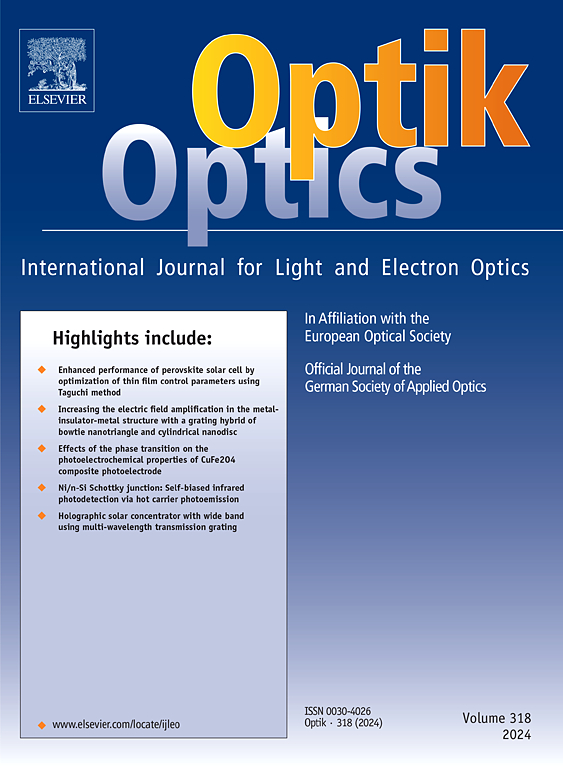研究用于癌细胞和化学物质检测的具有宽带共振的双等离子材料集成扳手形 PCF 传感器
IF 3.1
3区 物理与天体物理
Q2 Engineering
引用次数: 0
摘要
这项研究设计了一种基于局部表面等离子体共振的独特光子晶体光纤,用于癌细胞和化学物质检测。沿着两个水平狭缝沉积了一种新型等离子材料组合,即掺铝氧化锌(AZO)和银(Ag)-二氧化钛双层材料,从而在特定折射率范围内实现两个不同波长的共振。传感器在 x 和 y 偏振的不同波长上产生共振,从而扩大了特定折射率的分析检测范围。引入了两种工作模式:模式-1 经过优化以实现最高的振幅灵敏度 (AS),模式-2 则最大限度地提高了波长灵敏度 (WS)。模式-1 的 RI 范围为 1.35 至 1.42,另一种为 1.35 至 1.41。在 RI 为 1.36 时,Ag 传感器的 AS 值为 4641.51 RIU-1,这是文献中发现的使用 Ag 作为质子材料时 AS 的最高值;而在 RI 为 1.41 时,AZO 的 AS 值高达 3204.51 RIU-1。在 1.41 RI 时,使用模式-2 配置可获得 10,320 的最高 WS 值和 8089.5 nm/RIU 的双峰位移灵敏度 (DPSS),波长分辨率为 9.69 × 10-6 RIU,最大 FOM 为 568.22 RIU-1。通过分析 Basal、HeLa 和 Jurkat 细胞,该传感器被用于研究皮肤癌、宫颈癌和血癌。此外,本研究还对丙酮、正己烷、异丙醇和乙醇等各种工业化学品进行了检测。本文章由计算机程序翻译,如有差异,请以英文原文为准。
Investigation of dual plasmonic material integrated wrench-shaped PCF sensor with broadband resonance for cancer cell & chemical detection
In this work, a unique Photonic Crystal Fiber based on the Localized Surface Plasmon Resonance is designed for cancer cell and chemical detection. A novel combination of plasmonic materials namely Aluminum doped Zinc Oxide (AZO) and a Silver (Ag)-TiO2 bilayer is deposited along two horizontal slits to achieve resonance at two separate wavelengths within a particular refractive index. The sensor achieves resonance at different wavelengths along x and y polarizations, broadening analyte detection for a specific RI. Two modes of operation are introduced: mode-1 is optimized to achieve the highest Amplitude Sensitivity (AS), and mode-2 to maximize the Wavelength Sensitivity (WS). The mode-1 is examined for a range of RI from 1.35 to 1.42, while the other is 1.35–1.41. The sensor can showcase an AS of 4641.51 RIU−1 for Ag at RI 1.36, which is the highest value of AS found in literature when Ag is used as plasmonic material, while AZO achieves a high AS of 3204.51 RIU−1 at 1.41 RI. A highest WS of 10,320 and a Double Peak Shift Sensitivity (DPSS) of 8089.5 nm/RIU at 1.41 RI is obtained using the mode-2 configuration with a wavelength resolution of 9.69 × 10−6 RIU and a maximum FOM of 568.22 RIU−1. The sensor is examined to investigate skin, cervical, and blood cancer by analyzing the Basal, HeLa, and Jurkat cells, which yielded superior outcomes when detected using AS among relevant works. In addition, the detection of various industrial chemicals like acetone, hexane, isopropanol, and ethanol is also manifested in this study.
求助全文
通过发布文献求助,成功后即可免费获取论文全文。
去求助
来源期刊

Optik
物理-光学
CiteScore
6.90
自引率
12.90%
发文量
1471
审稿时长
46 days
期刊介绍:
Optik publishes articles on all subjects related to light and electron optics and offers a survey on the state of research and technical development within the following fields:
Optics:
-Optics design, geometrical and beam optics, wave optics-
Optical and micro-optical components, diffractive optics, devices and systems-
Photoelectric and optoelectronic devices-
Optical properties of materials, nonlinear optics, wave propagation and transmission in homogeneous and inhomogeneous materials-
Information optics, image formation and processing, holographic techniques, microscopes and spectrometer techniques, and image analysis-
Optical testing and measuring techniques-
Optical communication and computing-
Physiological optics-
As well as other related topics.
 求助内容:
求助内容: 应助结果提醒方式:
应助结果提醒方式:


